
Southern valve gear was briefly popular on steam locomotives in the United States. It combines elements of the Walschaerts and Baker patterns.

Southern valve gear was briefly popular on steam locomotives in the United States. It combines elements of the Walschaerts and Baker patterns.
Southern valve gear was devised by locomotive designers on the Southern Railway and used on many locomotives on that line. The first patent was issued to Wm. Sherman Brown in 1906. He continued work and another patent was issued July 23, 1912. The gear was first tested on Mikado 586 in February, 1913 at Southern Knoxville Shops. It was specified for some USRA standard locomotive designs, though many locomotives constructed to these patterns used Walschaerts or Baker valve gear instead. The Southern valve gear was used on many Southern Railway locomotives, including survivors 630 and 722. It was also used on East Broad Top numbers 16-18, which survive today. 16 was restored to operational condition in 2023.
Unlike the Walschaerts and Baker systems, the Southern valve gear dispensed with the combination lever which transmitted some of the crosshead motion to the valves. As with those systems it used a return crank on a driver (instead of the eccentrics used by the Stephenson valve gear). The return crank attached to the eccentric rod, which hung from a pivot close to the far end of the eccentric rod. This pivot attached to the end of the radius hanger, the other end of which attached to a link block which slid back and forth in a track curved in the same manner as the expansion link of a Walschaerts gear. In this system, however, the track was fixed in place; sliding the link block back and forth controlled reversing and cutoff.
At the end of the eccentric rod, close to the radius hanger, the rod connected to the transmission yoke. The upper end of this rod connected to a bellcrank, which translated the up and down motion of the transmission yoke into back and forth motion of the valves.
The mechanism is a little less obvious than that of the other types, but control is fundamentally like that of the Baker system. In this case the controlling factor is the angle between the radius hanger and the transmission yoke; when they are parallel, there is little up-down motion of the transmission yoke and the engine is centered. As link block moves back and forth, the angle of the radius hanger changes, and the up and down motion of the transmission yoke in response to the back and forth motion of the eccentric rod is increased or decreased.

Mason Bogie locomotives are a type of articulated tank locomotive suited for sharp curves and uneven track, once commonly used on narrow-gauge railways in the United States. The design is a development of the Single Fairlie locomotive.

A geared steam locomotive is a type of steam locomotive which uses gearing, usually reduction gearing, in the drivetrain, as opposed to the common directly driven design.

The valve gear of a steam engine is the mechanism that operates the inlet and exhaust valves to admit steam into the cylinder and allow exhaust steam to escape, respectively, at the correct points in the cycle. It can also serve as a reversing gear. It is sometimes referred to as the "motion".

The Walschaerts valve gear is a type of valve gear used to regulate the flow of steam to the pistons in steam locomotives, invented by Belgian railway engineer Egide Walschaerts in 1844. The gear is sometimes named without the final "s", since it was incorrectly patented under that name. It was extensively used in steam locomotives from the late 19th century until the end of the steam era.
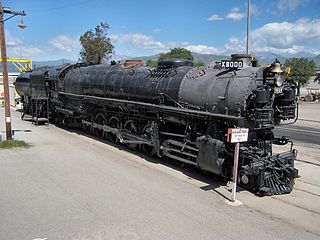
The Union Pacific Railroad 9000 Class was a class of 88 steam locomotives, built by ALCO for the Union Pacific between 1926 and 1930.
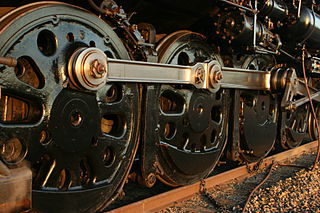
A coupling rod or side rod connects the driving wheels of a locomotive. Steam locomotives in particular usually have them, but some diesel and electric locomotives, especially older ones and shunters, also have them. The coupling rods transfer the power of drive to all wheels.

The Gresley conjugated valve gear is a valve gear for steam locomotives designed by Sir Nigel Gresley, chief mechanical engineer of the LNER, assisted by Harold Holcroft. It enables a three-cylinder locomotive to operate with only the two sets of valve gear for the outside cylinders, and derives the valve motion for the inside cylinder from them by means of levers. The gear is sometimes known as the Gresley-Holcroft gear, acknowledging Holcroft's major contributions to its development.
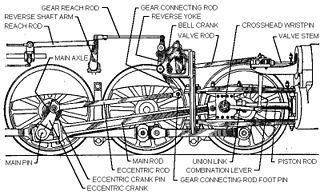
After about 1910, the Baker valve gear was the main competitor to Walschaerts valve gear for steam locomotives in the United States. Strictly speaking it was not a valve gear but a variable expansion mechanism adapted to the Walschaerts layout replacing the expansion link and sliding die block. The Baker arrangement used more pivot bearings or pin joints, but avoided the die slip inherent to the expansion link, with the aim of lessening wear and the need for service; it could also facilitate longer valve travel.

The Stephenson valve gear or Stephenson link or shifting link is a simple design of valve gear that was widely used throughout the world for various kinds of steam engines. It is named after Robert Stephenson but was invented by his employees.

The Prussian state railways' Class P 10 were 2-8-2 "Mikado" type passenger-hauling steam locomotives built for hauling heavy express trains in the hilly terrain of the Mittelgebirge. They were the last Prussian passenger train steam locomotives to be developed in Prussia before the state railways were merged into the Deutsche Reichsbahn, who eventually designated them as DRG Class 39.

Joy valve gear is a type of steam locomotive valve gear, designed by David Joy, Locomotive and Marine engineer, and patented on 8 March 1879. The British patent has not been found but the US patent has. Joy's gear is similar to Hackworth valve gear but has a compensating mechanism which corrects for "the slight inequality in the motion of the valve arising from the arc of the lever".

The Baguley valve gear is a type of steam engine valve gear invented by Ernest E. Baguley, the Chief Draughtsman of the W.G. Bagnall company of locomotive manufacturers and patented in 1893. It was used by Bagnall during Baguley's time there, then by his own company of Baguley Cars Ltd.
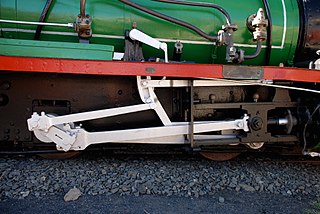
Bagnall–Price valve gear is a type of steam engine valve gear developed at locomotive manufacturer W.G. Bagnall as an alternative to the more common Walschaerts valve gear and also to supersede the Baguley valve gear their designs had previously utilised. The gear was patented in 1903 by W.G. Bagnall and T. S. Price, the manager of the works.
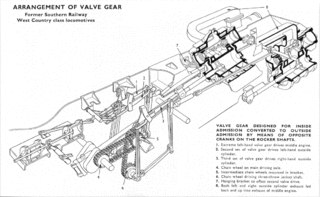
The Bulleid chain-driven valve gear is a type of steam locomotive valve gear designed by Oliver Bulleid during the Second World War for use on his Pacific (4-6-2) designs. It was peculiar to the Southern Railway in Britain, and borrowed from motor-vehicle practice in an attempt to create a compact and efficient design with a minimum of service requirements.

The Kuhn slide is part of a modified Walschaerts valve gear on steam locomotives and is named after its inventor, Michael Kuhn (1851–1903). The term is also used to refer to this particular type of Walschaerts valve gear system as a whole.
Harold Holcroft was an English railway and mechanical engineer who worked for the Great Western Railway (GWR), the South Eastern and Chatham Railway (SECR) and the Southern Railway (SR).

James Thompson Marshall was an English railway and mechanical engineer known for inventing the 'Marshall valve gear' for steam locomotive use. James Marshall began his engineering career at the Leeds-based Steam Plough Company, and later moved to the city's Boyne Engine Works.

The Holcroft valve gear was a type of conjugated valve gear designed and patented by Harold Holcroft and used on three-cylinder steam locomotives of the South Eastern & Chatham Railway (SECR). It bore many similarities to the Gresley conjugated valve gear, which it predated, as eventually used on all Gresley's three cylinder designs. It varied from the Gresley method of operation by using the combination lever assembly instead of the valve spindles to drive the middle cylinder of a three-cylinder design. This had operational advantages over Gresley's design, namely eliminating the problems of flexure, bush wear and the influence of heat in the valve spindles.

The Cape Government Railways Fairlie 0-6-0+0-6-0 of 1876 was a South African steam locomotive from the pre-Union era in the Cape of Good Hope.
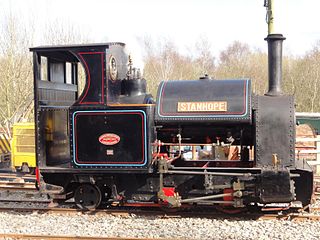
The Hackworth valve gear is a design of valve gear used to regulate the flow of steam to the pistons in steam engines. It is a radial gear, with an actuating lever driven from the crank. The drive may be taken directly from the crank or indirectly via a return crank. The other end of the actuating lever is attached to a die block which slides in a slotted link. When the link is vertical, the engine is in mid-gear. Forward, reverse and cut-off adjustments are made by moving the link away from the vertical. The valve rod is pivoted to a point on the actuating lever.